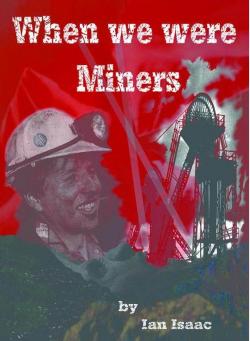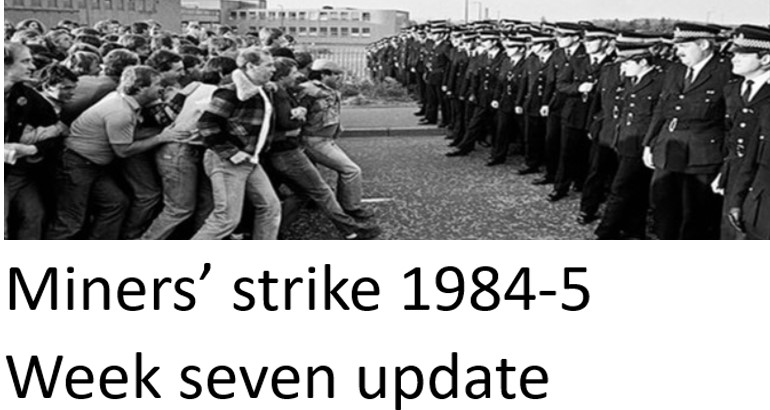By Mark Langabeer, Newton Abbot Labour member
When we were Miners is a book written by Ian Isaac who was a miner for over 15 years and held the post of Branch Secretary of the St John’s colliery in South Wales, until it’s closure. He also served as a member of the South Wales Executive Committee of the NUM.
It is now just over 35 years since the titanic year long strike by miners to prevent pit closures and this book is a personal account of his experiences as an active participant within the National Union of Mineworkers, before, during and after the great strike.
The book sets out, and succeeds, in debunking “two great lies” about the mining industry in the early 1980s. “The first was that in the run-up to and during the 1984-85 miners’ strike many of the pits in the British coalfields were uneconomic and had to be shut accordingly to stop ‘losing’ money for the taxpayer. The second big lie has been that it was the miners’ decision to take strike action in 1984-85 that led to the speeded-up demise of the industry.”
The National Union of Mineworkers was regarded in those days as the vanguard of the trade union movement, due to its victories in 1972 and 1974, winning better pay and conditions. Ultimately the second of these led to the downfall of Tories and the election of a Labour Government.
Selling off state industries
The Tories, when they were re-elected under Thatcher in 1979, were determined to break the power of the unions with the aim of driving up private profit and selling off state-owned industries. In order to do this, they needed to defeat the unions and in particular the NUM. All the advances made during the post-war period by the labour and trade union movement were under attack and the defeat of the miners was key to this end.
Despite a magnificent struggle against pit closures, the miners’ strike was defeated and the consequences remain with us still. As Ian writes, “The closure of the coal mines had ruinous results in the mining communities of Britain.” Many of the former mining communities are still broken today, thirty-five years later.
It is not my aim here to to give a detailed account of the book, which is a refreshing and interesting read, far better than some of the stuff you can read today about that strike. It has 200 pages and is dedicated to Andrew Glyn, a Marxist economist who wrote a powerful economic case for keeping the pits open.
There were many outstanding activists thrown up during the course of the struggle; however few, in my view, as effective as Ian. If there had been hundreds more Ian Isaac’s within the NUM and thousands within the unions generally, then the outcome of the strike might have been different. He was armed with the genuine ideas of Marxism and he understood the general line of march, strategy and tactics required to defeat Thatcher and the class that she represented.
Many speaking tours around Britain
I have one bone to pick with Ian. During his many tours around Britain and abroad, he highlighted the fact that he had sat next to the great Mohammed Ali and explained the reasons for the strike to him. I met Ian once, he stayed at my flat one evening, before a speaking tour around Kent and for some inexplicable reason, he failed to mention this in his book!
On a more serious note, this book is a must for all to read, particularly younger activists within the Labour Movement. It is now just over ten years since its original publication, but it is well worth republishing and reviving for younger readers. Ian mentions that many union leaders turned on NUM president, Arthur Scargill, after the strike. They did this to distract from their own failure to mobilise sufficient support for the miners.
Like Corbyn, Scargill was demonized by the establishment. Anyone who represents a threat to the wealth, power and privileges of the bosses will be vilified in the same way. As the saying goes, if you’re not attacked by these people, you’re not doing your job.
Endless austerity and insecurity
Following the defeat of the miners, it became commonplace to hear workers say that the unions no longer have any power, or that if the miners can’t win, then no-one can. Trade union membership has fallen from a peak in 1979 of over 13 million to around 6 million today. The number of days lost as result of strikes has fallen dramatically since the 70s and 80s. The effects of this defeat were similar to those that followed the defeat of the General Strike of 1926. But time heals and the processes at work within society, particularly the endless austerity and insecurity that workers face, will drive millions back into trade unions.
Trotsky wrote a pamphlet called Against the Stream in the late 1930s. He argued that it was big events which will change the outlook of the mass of workers. The Second World War had such an effect. It has been reported that there has been a recent rise in union membership and a growth in active participation of members. Covid 19 may well prove to be the catalyst for a revival of the trade unions and for the re-growth of militancy within the workers organisations.
The book is still available as a Kindle or hard copy edition from Amazon, but you can always contact the author for a copy: ian.isaac@yahoo.co.uk.
July 29, 2020



